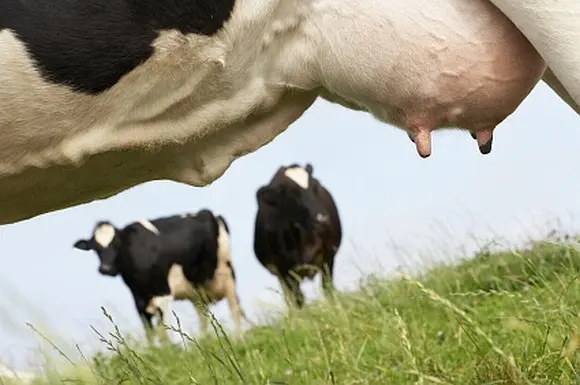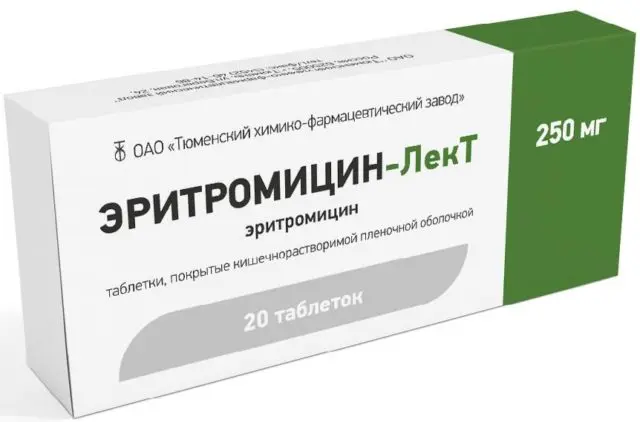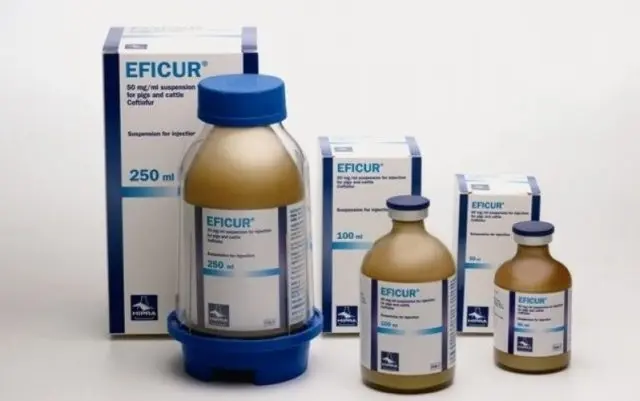Contents
The most important thing in the fight against this disease is to identify the alarming symptoms in time, and the treatment of latent mastitis in a cow. After that, the process proceeds quite successfully and does not cause complications. Difficulties arise if the disease becomes chronic or catarrhal, which can cause a complete cessation of lactation without the possibility of recovery. In this regard, it is important to know how to independently identify hidden mastitis at an early stage, and provide first aid to a sick animal.
Subclinical (or latent) mastitis in cows is an inflammatory process in the udder of an animal that affects one or more of its lobes. The difficulty of treating subclinical mastitis in cattle lies in the fact that the symptoms of the disease are hidden – the cow can be sick for quite a long time, but this will not manifest itself outwardly, except for minor physiological changes that are easy to miss. There are no acute manifestations of latent mastitis, especially at the initial stage.
Causes of latent mastitis in cows
There can be many reasons for subclinical (hidden) mastitis in cattle. The most common include the following negative factors that can adversely affect the condition of the udder:
- Unsatisfactory conditions of detention. Very often, subclinical mastitis occurs in weakened animals that are in a damp and cold room with insufficient heating. It also includes lack of light and poor ventilation. Dirty bedding only increases the risk of inflammation.
- mechanical injury. Hidden mastitis can develop in a cow after pathogenic microbes enter the mammary glands, which usually occurs through scratches and cracks in the udder. Weakened immunity only contributes to this, since the animal does not have enough strength to fight the infection on its own.
- Unsanitary conditions in work with cattle. Hidden mastitis can be provoked in a cow by the person himself – through dirty hands, E. coli and other microbes can penetrate into the blood and lymph of the animal, causing inflammation.
- Hardware milking of cows. On farms where animals are not milked by hand, the risk of subclinical mastitis is 15-20% higher. This is due to violations in the operation of milking machines, poor-quality equipment and inability to use it.
- Diseases of the gastrointestinal tract. Sometimes latent mastitis is the result of another disease.
- Difficult childbirth. The likelihood of latent mastitis increases with retention of the placenta and endometritis – inflammation of the uterine mucosa.
- Incorrect start of the cow. Most often, subclinical mastitis affects cattle precisely during the start-up and dry period. In this regard, it is especially important to monitor the health of animals during this period.

Symptoms of latent mastitis in cows
The treatment of latent mastitis in cows largely depends on how early the presence of inflammatory processes is diagnosed in a sick animal. Most often, the disease can be determined only after calling the veterinarian, but you can also identify a number of signs by which hidden mastitis is determined independently. It is difficult to do this, since the changes are minor, but there is still a chance.
The primary symptoms of subclinical mastitis are as follows:
- milk yield decreases, but this happens gradually, and there are no changes in nutrition;
- the consistency of milk becomes slightly different – it loses its original density and becomes slightly watery, which is associated with a change in the chemical composition;
- as subclinical mastitis progresses, small lumps begin to form in the udder.
If nothing is done at the initial stage of the development of the disease, secondary signs of latent mastitis begin to appear, which are already difficult to miss:
- the mammary glands become inflamed – the nipples noticeably swell;
- the temperature of the udder rises, its swelling becomes noticeable;
- touching the udder with hidden mastitis causes pain in the cow, as a result of which the animal often steps from foot to foot and beats with its hoof during milking;
- nipples become dry, cracks appear on them;
- in milk there are small clots or flakes of white color.
Thus, the very fact that milk yield began to decrease for no apparent reason is already a reason to be wary. It is better to play it safe and call a specialist to examine the cow. The veterinarian must take a milk sample from the animal, after which, through a laboratory test, it is determined for sure whether the cow has subclinical mastitis or these are signs of another disease.
Studies on subclinical bovine mastitis
The primary diagnosis of latent mastitis is carried out through a visual examination. The veterinarian should look for the following signs of subclinical mastitis:
- the mammary gland has slight seals in one or more lobes, they are jelly-like to the touch;
- the overall size of the udder is reduced;
- the walls of the nipples are noticeably thicker.

Unfortunately, these signs indicate an already progressive latent mastitis. At the initial stage of the development of the disease, its presence can only be determined in the laboratory. For this, special tests are carried out, in which milk from cows with suspected subclinical mastitis is examined.
Somatic cell count in milk
The express method consists in counting somatic milk cells – with latent mastitis, their number in the expressed product increases several times, and leukocytes dominate over erythrocytes. In addition, with latent mastitis, studies should reveal the following changes:
- the disease is evidenced by the reduced acidity of the product;
- there is an increase in the number of albumins and globulins;
- the proportion of protein in milk is significantly reduced, and there is also a drop in the level of calcium and phosphorus.
Diagnosis by milk-control plates
Subclinical mastitis in cows is also determined in the laboratory by reacting to the following reagents:
- “Mastidine” (2%);
- “Dimastin” (2%);
- “Mastoprim” (2%).
In this case, special milk-control plates MKP-1 and MKP-2 are used, each of which contains four recesses. A test for hidden mastitis is carried out according to the following scheme:
- From each share, it is necessary to collect 1-2 ml of milk and pour it into the appropriate slots.
- Then 1 ml of the reagent is added to it and the resulting mixture is stirred with a glass rod.
- After 15-20 seconds, the milk should thicken or change color.
If there is a thickening of milk to a jelly-like state, the presence of latent mastitis in a cow is confirmed. The resulting viscous mass can be easily pulled out of the recess with a glass rod.
If no reaction occurs, then the animal is healthy or has other problems unrelated to subclinical mastitis.
Settling milk
Additional diagnosis of subclinical mastitis in cows is carried out by settling. This process looks like this:
- In test tubes, 1-2 cm of fresh milk is collected from each nipple.
- The containers are put in the refrigerator for 15-16 hours.
- The holding temperature should be between -5-10°C.
After that, under good lighting, the reaction to subclinical mastitis is checked – if the milk was taken from a healthy cow, then it has a white or slightly bluish color, and no sediment is released. A small layer of cream appears on the surface.

The milk of a sick cow with latent mastitis forms a white or yellowish precipitate, and the cream layer does not appear.
How to treat latent mastitis in cows
Treatment of latent mastitis in cows begins with the isolation of the sick individual from the rest of the livestock. The animal is placed in a separate stall, provided with dietary food to reduce milk production, and left alone. If a cow has a pronounced swelling of the udder, it is necessary to reduce the amount of drinking water for the animal.
The next stage of treatment of subclinical mastitis involves physiotherapy, which includes the following set of measures:
- UHF;
- laser therapy;
- infrared heating;
- ultraviolet irradiation;
- application of compresses and applications with paraffin.
Complete recovery from subclinical mastitis is impossible without the use of antibiotics. It is not recommended to select them on your own, the treatment should be prescribed by a veterinarian. Most often, the following drugs are used to combat latent mastitis:
- “Erythromycin”. One tablet must be dissolved in a small amount of ethyl alcohol and mixed with water. Injections are carried out in the mammary gland, while the interval between them should be at least a day. Multiplicity of processing – three times.

- “Mastisan E”. Injections are carried out at the same frequency. The dosage is set by the veterinarian.

- Tylosin 200. The drug is administered intramuscularly at intervals of once a day. The recommended dosage is 8-10 ml of the product. Enter the drug for three days.

- “Ephikur”. The medicine is intended for subcutaneous injection. The dosage is calculated based on the weight of the animal – for every 50 kg of weight, 1 ml of the drug is needed. Use “Efikur” for three days.

- Mastiet Forte. The drug is used for injection into the udder. The peculiarity of the action lies in the fact that the product contains both an antibiotic and components for relieving inflammation. The dosage is calculated by the veterinarian.

Enter these funds intravenously, orally or intramuscularly. The action of drugs is based on the neutralization of the toxicity of pathogenic bacteria.
Additionally, sick cows with latent mastitis are injected with fresh milk from healthy individuals with a frequency of 1-2 times a day. Novocaine udder blockades have proven themselves well in the fight against subclinical mastitis. All solutions must be warmed to normal body temperature before ingestion.
Approximately 7-10 days after the start of treatment, it is necessary to re-examine the milk of sick cows. If the test result is again positive, the cattle continue to be treated according to the indicated scheme until the test shows a negative reaction.
Preventive measures
Timely treatment of subclinical mastitis in cows usually does not cause any particular difficulties, but it is still better to minimize the risk of the disease. Since most often latent mastitis occurs as a result of improper start-up, a number of rules must be observed during this period:
- succulent feeds and concentrates are completely removed from the diet of animals, or at least their total amount is halved;
- the cow is gradually transferred to a two-time milking, after which they are transferred to a single milking;
- the next step is milking every other day;
- complete the transition process by a complete cessation of milking.
In addition, in order to prevent latent mastitis, it is important to provide animals with good care and maintenance. Bedding should be changed regularly to reduce the risk of udder infection through dirty environments, and the room should be regularly ventilated.
Conclusion
If the owner identified the symptoms in time, and the treatment of latent mastitis in a cow takes place under the supervision of a veterinarian, then the chances of recovery in a sick animal are high. On the other hand, it is better, in general, to prevent the likelihood of developing latent mastitis, for which it is necessary to observe all preventive measures against this disease. It is also recommended to analyze milk samples 1-2 times a month, preferably before starting a cow.
At the end of treatment, it is necessary to hand over milk from a sick animal to the laboratory. Only after confirming that the cow is healthy, the veterinarian removes the quarantine. Cattle are transferred back to other individuals, and the milk can again be eaten.
For more information on how to treat subclinical mastitis in cattle, see the video below:














